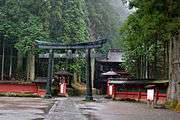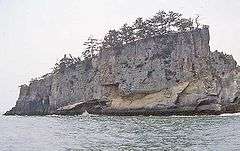Narrow Road to the Deep North
The Narrow Road to the Deep North (奥の細道 Oku no Hosomichi) is the title of famed haiku poet Matsuo Basho's most famous work, a poem-filled travelogue through Japan's remote northeastern region of Tohoku.
- This article is an itinerary.
Understand
|
Matsuo Basho Born Matsuo Munefusa in 1644 in the town of Ueno near Kyoto, Matsuo Bashō (松尾芭蕉) is generally regarded as Japan's greatest haiku poet, largely responsible for creating the art form with its 5-7-5 syllable syntax. His pseudonym Bashō means "banana tree", chosen after a fruitless tree near his hut. He achieved a modest degree of fame during his lifetime with gems such as this:
Tired with a sedentary life, in 1684 he embarked on the first of his many trips, traveling to Mount Fuji and Ise. His art reached its greatest form during his five-month trip to the Deep North in 1689, during which he wrote his masterpiece The Narrow Road to the Deep North developing his concept of sabi, the identification of man with natural beauty. Basho died in 1694 shortly after leaving Kyoto on another trip, and is buried in the town of Otsu. |
One of the most famous travelogues ever, the Narrow Road continues to inspire Japanese art and visitors to Tohoku, and each of the places Basho visited continues to revere his poems and observations.
In Basho's day, the land of Oku (奥), literally "Within", was the back of beyond in Japan, where farmers eked out a meager living and bandits and hermits roamed in the mountains. Well aware of the dangers awaiting him, Basho fully expected to never return, selling his house and preparing a will.
When reading Basho's work, it is important to note that he takes more than a few poetic liberties with the exact route chosen and the sights seen. Fortunately, he traveled for most of the way with fellow poet Sora, whose more factual diary has allowed the reconstruction of the route.
Prepare
- 予もいづれの年よりか、片雲の風にさそはれて、漂泊の思ひやまず、海浜にさすらへ
- There came a day when the clouds drifting along with the wind aroused a wanderlust in me, and I set off on a journey to roam along the seashores...
Back in 1689 Basho walked the entire distance, starting in late spring and taking over five months (156 days, to be precise) for the entire journey. Even with the assistance of modern transportation and perfect scheduling (public transport is sparse in this neck of the woods), it would take a month for a whirlwind tour of all visited sights.
Due to Basho's predilection for mountain climbing, a faithful copy of the itinerary can only be done in summer, after the heavy snows of the Sea of Japan coast have melted and the mountains are accessible.
Get in
The starting point of the trip is Tokyo, the capital of Japan. As the first stretch of the trip has been largely absorbed into urban sprawl, many choose to head straight for Sendai (Stage 18) and start their trip there (with a possible detour to Nikko).
Go


Basho's original itinerary is as follows, with modern place names or major nearby cities in parentheses where applicable.
Basho starts off from the heart of downtown (shitamachi) Tokyo, bidding farewell to Ueno and Yanaka — both well worth a visit.
- Stage 3: Soka
- Stage 4: Muronoyashima
- Stage 5: Nikko
Intriguingly, Basho does not even mention Nikko's largest tourist draw, the extravagant Tokugawa mausoleums. Instead, he climbs Mt. Nikko and visits Futarasan Shrine, dedicated to the mountains' guardian spirits.
- Stages 6-9: Nasu (Kurobane, Unganji, Sesshoseki)
- Stage 10: Shirakawa
- Stage 11: Sukagawa
- Stage 12: Asaka (Fukushima)
- Stage 13: Shinobu
- Stage 14: Sato Shoji
- Stage 15: Iizuka
- Stage 16: Kasajima
- Stage 17: Takekuma
- Stage 18: Sendai
In Sendai, Basho met with a famous artist, Kaemon, whom he admired. Kaemon showed him some of his favorite places, such as Miyagino (no longer in existence), Mutsu Kokubunji's Yakushido, and Tsutsujigaoka Tenmangu Shrine.
- Stage 19: Tsubo no Ishibumi (Ichikawa)
- Stage 20: Shiogama
Matsuo's chosen route of boarding a boat here for Matsushima remains very popular today.
- Stage 21: Matsushima
The craggy pine tree islands here are considered one of Japan's Top 3 scenic spots.
- Stage 22: Ishinomaki
- Stage 23: Hiraizumi
Once a capital that rivaled in Kyoto in splendor, today's Hiraizumi has little left except two famous temples — and some famous haiku lamenting the loss penned here by Basho.
- Stage 24: Dewagoe (Naruko)
At this point Basho abandoned the original plan to head all the way north to Aomori and instead decided to head across the mountains. Naruko is now a popular hot spring resort.
The temple of Ryushakuji is quite literally carved out of the mountainside: hence the common name Yamadera, "Mountain Temple".
- Stage 27: Oishida
- Stage 28: Mogami River (Yamagata)
- Stages 29-30: Hagurosan and Gassan (Dewa Sanzan)
The three holy mountains of Dewa Sanzan are the center of worship for the Shinto-Buddhist Shugendo sect and its mountain-climbing yamabushi ascetic monks. Note that Basho only visited Hagurosan and Gassan. He never made it to the third, Yudonosan.
The province of Echigo is now Niigata prefecture.
In Komatsu, Basho visited Natadera, a famous temple still visited by many Japanese (but few foreign tourists).
In Tsuruga, Basho visited the famous Kehi Shrine and stayed at Kanegasaki to observe the full moon. He wrote one of his haiku at Konzenji Temple at the foot of Kanegasaki about the temple's famous bell.
- Stage 42: Ironohama
- Stage 43: Ogaki
Stay safe
The roaming bands of Ainu bandits that Basho feared (but did not encounter) are long since gone. Now the riskiest parts of the trip are inclement weather and the mountain ascents.
Go next
The ending point is Ogaki, which is 30 minutes by rail from Nagoya, a Tokaido Shinkansen stop. Nagoya is home to the Chubu Centrair International Airport. Ogaki is also not so far from Kansai, and it is only a few hours back to Tokyo.
You might also wish to detour to Iga where Basho was born or Otsu on the shores of Lake Biwa, where Basho died in 1694. He is buried in that city at the small temple of Gichu-ji.